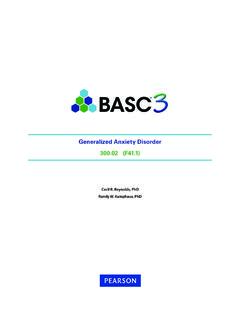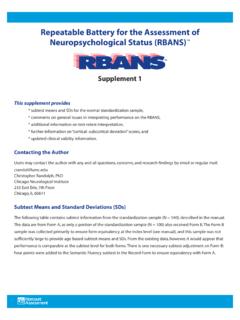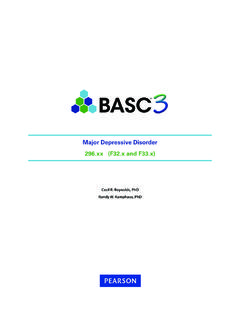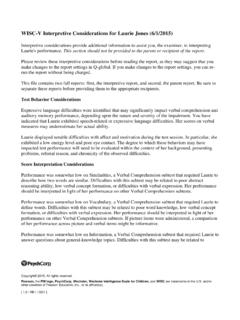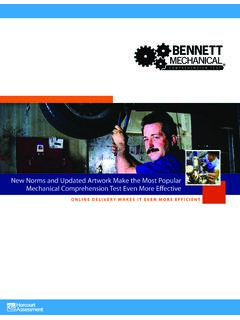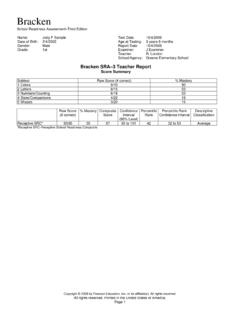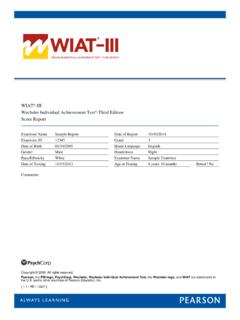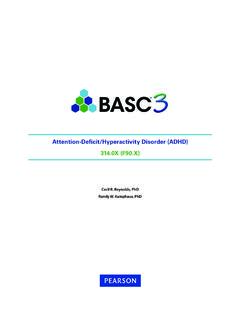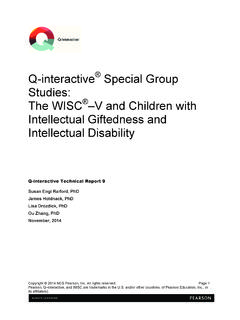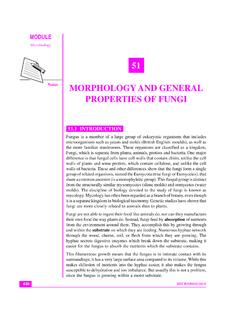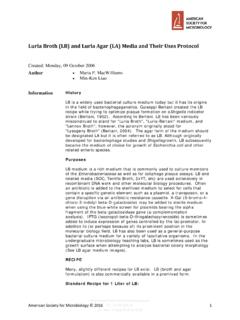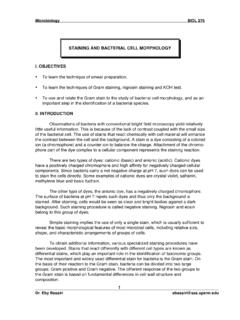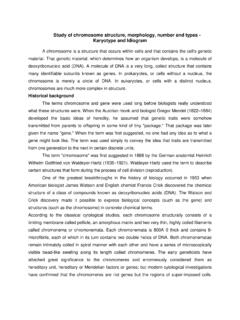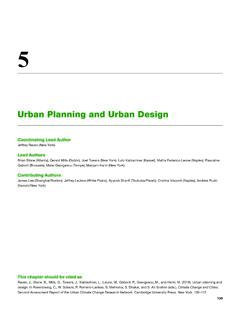Transcription of Overview of the CELF-5 Assessment Process
1 Overview of the CELF-5 Assessment ProcessElisabeth H. Wiig, PhD, Eleanor Semel, EdD & Wayne A. Secord, PhDOverview of the Assessment Process 2 The CELF-5 battery presents an Assessment Process that takes into account the initial steps of the clinical decision-making, including: Recommending classroom language adaptations and accommodations. Determining eligibility for in-classroom interventions or direct services. Providing norm-referenced information that aids in the diagnosis of a language disorder and determine eligibility for services. Identifying communication strengths and weaknesses. Identifying deficits in reading comprehension and written expression.
2 Planning curriculum-relevant intervention. Measuring treatment efficacy (Salvia, Ysseldyke, & Bolt, 2013).With this revision of CELF, clinicians can evaluate a student s general language ability and obtain information that assists in determining if the student has a language disorder by administering four to six tests. Once it is determined that a student has a language disorder, the Assessment Process can extend to: Identifying significant differences in comprehension and expression Determining if the student has weaknesses in the area of morphology and syntax or semantics Determining how the oral language disorder affects the student s written language skills Determining if the disorder affects the student s social language interactionsCELF-5 provides efficiency and flexibility to administer only the tests needed to correspond to the objectives for Assessment and evaluation.
3 The CELF-5 Assessment Process is illustrated in Figure Is a language disorder affecting classroom performance?Evaluate language and communication in context using the Observational Rating Scale (ORS) and other authentic and descriptive measures to provide information about classroom accommodations, adaptations, and enhancements. If the student does not respond to a variety of classroom interventions, is his or her performance due to language skill deficits?Administer tests appropriate to the student s age to answer the referral questions. If a language disorder is identified, what do I need to know to plan for intervention?
4 Identify the nature of the disorder by answering the following there significant differences in comprehension and expression?Administer tests comprising the Receptive and Expressive Index scores. Are weaknesses related to the interaction of language and memory?Administer tests comprising the Language Memory index there weaknesses in the areas of morphology , syntax, or semantics? Administer tests comprising the Language Content or Language Structure index does the disorder affect written language? Administer the Reading Comprehension and Structured Writing the disorder affect social interactions? Complete the Pragmatics Profile and/or the Pragmatics Activities on the CELF-5 test results and additional Assessment information you have collected, what is the best way to address the student s needs?
5 Overview of the Assessment Process 3 CELF-5 Diagnostic Battery FeaturesAs a diagnostic battery, CELF-5 is an important part of the total Assessment Process that can be used to collect evidence about a student s communication abilities in multiple contexts. The CELF-5 has a better balance of items across receptive and expressive modalities and language content and structure than its predecessors. It maintains standardized test scores and composite scores (Core Language and Index scores) to enhance clinical decision making. Growth Scale Values have been added to help measure student progress over time. In previous versions of CELF, each group of test items assessing a specific language skill was called a subtest.
6 CELF-5 has been developed and researched to enable examiners to use each group of items independently of the others. Consequently, each group of items that makes up CELF-5 , ( , Linguistic Concepts, Semantic Relationships, Understanding Spoken Paragraphs) is referred to as a test. The CELF-5 battery includes tests from previous editions and new tests for evaluating word meanings and vocabulary (semantics), word and sentence structure ( morphology and syntax), the rules of oral language used in responding to and conveying messages (pragmatics), and the recall and retrieval of spoken language (memory). It also includes the Observational Rating Scales (ORS) for authentic evaluation of communication in academic settings.
7 To meet the clinician s needs for a standardized measure of pragmatic skills, standard scores are now reported for the Pragmatics Profile. The Pragmatics Activities Checklist was added to assess social language skills during authentic conversational interactions. There are also new tests for evaluating aspects of literacy (reading comprehension and written language production).Summary of New Tests and Test ModificationsC E LF - 5 Te s tNew or Modified TestObservational Rating ScaleParent, teacher, and student each rate the student s classroom interaction and communication ComprehensionFormerly Sentence Structure in CELF-4; the student demonstrates understanding of sentence of increasing length and complexity by pointing to picturesLinguistic ConceptsFormerly part of Concepts & Following Directions in CELF-4; now a separate test examining comprehension of basic concepts.
8 Only 5-8 year old students take this StructureModified from CELF-4; slight increase in number of test items increased reliabilityWord ClassesNow one continuous set of test items (rather than two different tests) expressive portion of the test now an optional part of extension testing (saving administration time)Following DirectionsNow evaluate students ability to follow directions of increasing length and complexity separately from comprehension of basic conceptsFormulated SentencesModifications to test items and art based on user feedbackRecalling SentencesModifications to test items based on user feedbackUnderstanding Spoken ParagraphsNow includes questions about social content, as well as questions about a main idea, details, making inferences, event sequences, and DefinitionsSimplified 1,0 scoringSentence AssemblyModified from CELF-4.
9 Ceiling extended to include more difficult test itemsSemantic RelationshipsModified from CELF-4; ceiling extended to include more difficult test itemsReading ComprehensionNew test in which the student responds to questions about passages he or she readsStructured WritingNew test in which the student completes a short story by completing a sentence and writing one or more additional sentencesPragmatics ProfileModified from CELF-4; now includes standard scores and information about cultural considerations when rating responsesPragmatics Activities ChecklistNew test in which you engage the student in interactive activities presented as breaks during testingFor more information and examples of Stimulus Book and Record Form pages, go to 2013 Pearson Education, Inc.
10 Or its affiliate(s). All rights reserved. CELF, Always Learning, Pearson, design for Psi, and PsychCorp are trademarks, in the and/or other countries, of Pearson Education, Inc. or its affiliate(s). 8442 5/13 || of the Assessment Process For more information about CELF-5 , please visit or call @SpeechnLanguage #CELF5/SpeechandLangTable Type of Scores Available for Tests and Index ScoresTest or IndexScaled ScoreStandard Score (Composite)Te s t- A g e EquivalentCriterion Cut ScoreGrowth Scale ValueSentence ComprehensionXXXL inguistic ConceptsXXXWord StructureXXXWord ClassesXXXF ollowing DirectionsXXXF ormulated SentencesXXXR ecalling SentencesXXXU nderstanding Spoken ParagraphsXXXWord DefinitionsXXXS entence AssemblyXXXS emantic RelationshipsXXXP ragmatics ProfileXXXR eading ComprehensionXStructured WritingXPragmatics Activities ChecklistXCore Language ScoreXX*Receptive Language IndexXX*Expressive Language IndexXXLanguage Content IndexXX*Language Structure IndexXX*Test-age equivalents are not available for all ages because there are no
